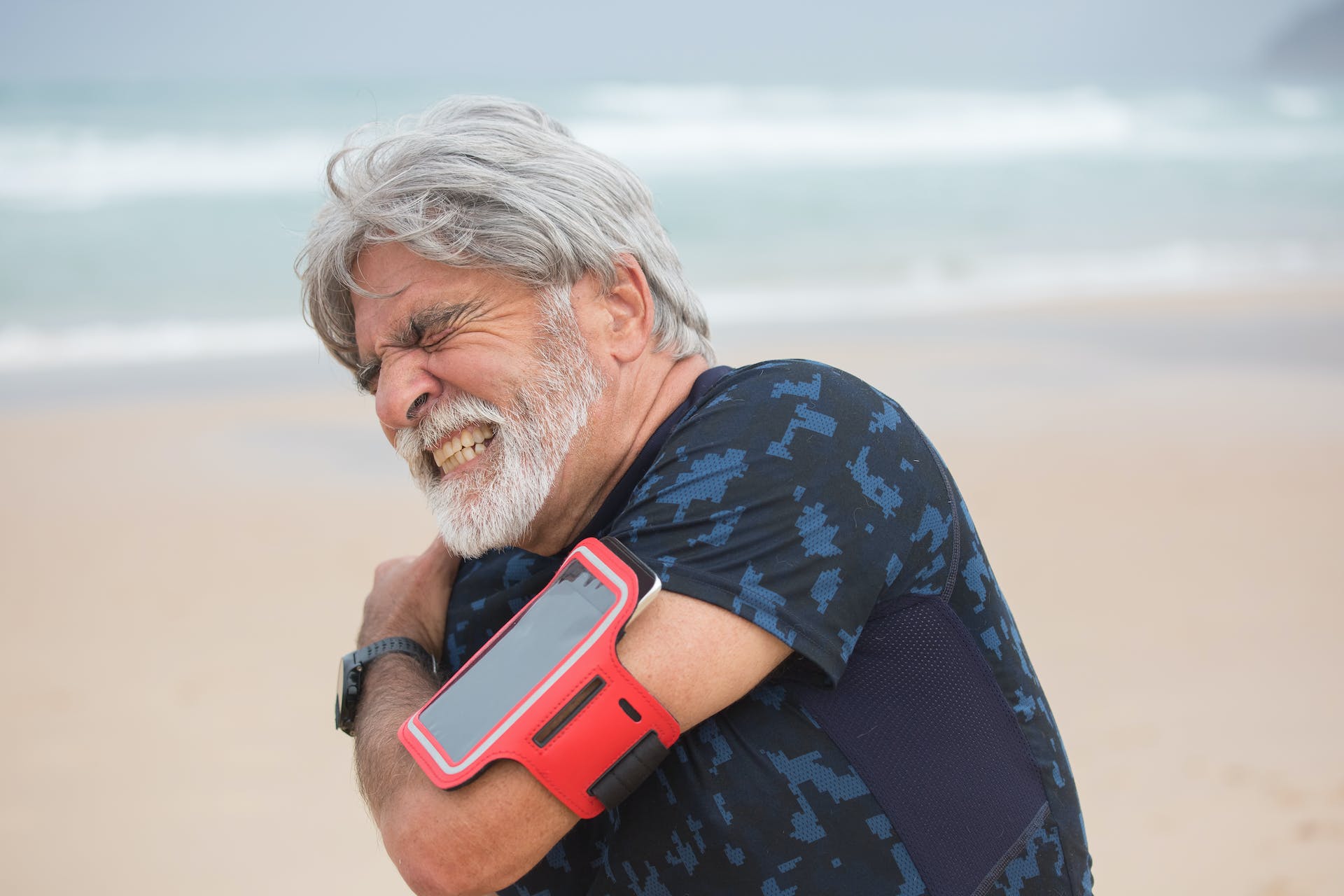How Blood Flow Affects Healing from Chronic Pain, Illness, Wounds, and More
The human body is a complex system with multiple functions occurring concurrently with each other and dependent on one another for optimal function. When all processes are running flawlessly, you would be considered to be in perfect health.
Unfortunately, aging, stress, injuries and/or trauma, genetics, and our daily lifestyle can begin to interrupt and/or limit one of our body’s main processes…the circulatory system.[i] This often leads to symptoms such as pain, infections, slow wound healing, and varicose veins as the circulatory system is unable to deliver essential nutrients, oxygen, and hormones to major organs throughout the body.
Over time, your ability to perform your normal daily activities is significantly reduced and your quality of life is often negatively affected as you suffer from ongoing symptoms of disease.
Thankfully, there are all-natural, non-invasive treatments that work to restore your body’s vital circulatory function, return your body to the parasympathetic state, and increase healing without the need for prescriptions or surgery.
Understanding your cardiovascular health is the first step to recognizing potential issues, eliminating risk factors, and taking the first step on the road to optimal health. The information contained throughout this article can help you on your journey to better overall circulation and health.
What Does the Circulatory System Do?
Simply put, the circulatory system (also called the vascular system or cardiovascular system), is the fuel line for the entire body. Like how the fuel line in your car works to deliver gas to the engine, the circulatory system delivers fuel to every part of the body in the form of vital nutrients, oxygen, hormones, and other essential components.
It is a network of arteries, veins, and capillaries that work to send blood filled with essential components throughout the entire body to tissues, muscles, organs, nerves, etc., for stamina, growth, and repair. Plus, the circulatory system also plays a vital role in removing the body’s waste products from cells and organs so your body can dispose of them.
At the center of your circulatory system is your heart (the fuel pump) working in conjunction with arteries that carry oxygenated blood away from the heart and veins that return the depleted blood back to the heart. These arteries and veins can be larger in diameter than your thumb, as in the case of the aorta, or 5 times smaller than a single grain of salt (100 micrometers in diameter) which is called microcirculation.
Should the circulatory system become blocked or limited in any way, the transport of vital components is slowed and/or stopped completely leading to a multitude of health concerns and symptoms.
For example, if you slowed the flow of gas in your car’s fuel line, your car would not run correctly. It would lack power and stamina, or it would not function properly at all. This is the same process that happens within your body should your circulatory system be slowed, blocked, or hindered in any way.
Block the flow and bodily systems would lack the stamina and nutrients needed to function, would be unable to dispose of waste, and would lack the ability to repair tissue. This is especially concerning for the smallest vessels (microcirculation) as 70-90% of the overall blood flow resistance of the circulatory system arises at the level of the microcirculation[ii].
What is the Role of Microcirculation?
The microvascular system, which is responsible for microcirculation, is a branching network of microvessels (very tiny vessels) throughout your body that transport and exchange heat, respiratory gases, nutrients, waste products, water, and hormones between blood and the body’s tissues.[iii]
The microvasculature system consists of three types of small vessels: arterioles, capillaries, and venules that regulate local blood perfusion (blood flow) while water and solutes are carried by the blood through the microvessels and exchanged, through vessel walls, with the surrounding tissues.[iv]
This exchange provides hydration to organs, muscles, tissue, and the skin while speeding white blood cells to infectious areas, removing harmful waste, and ensuring essential components like collagen, hormones, and nutrients reach their destination.
An extremely large section of the microvascular system is found within the fascia. The health of the fascia is vitally important to one’s overall health as it protects and supports the deep structures and organs of the body. The fascia reduces friction between muscles, transmits movement from muscle to bones, and can serve as the attachment point for skeletal muscles.
It is located directly below your skin and extends around every muscle, organ, and tissue throughout your entire body. Therefore, microcirculation to the fascia is essential for movement, pain-free living, healing, and growth, while poor microcirculation can lead to pain, inflammation[v], slow healing times, and many other negative side effects.
Causes of Poor Microcirculation
Blood flow within your microvascular system can begin to decrease over time due to natural factors (such as aging, injury, environment, or stress) or because of chronic conditions (such as high blood pressure, disease, or diabetes).
According to a report in the AHA (American Heart Association) journal “Circulation”[vi], nearly half of all U.S. adults have some type of cardiovascular disease totaling 121.5 million adults. However, much of the restricted blood flow to microvessels can be contributed to natural factors.
Causes of poor microcirculation may include:
- Stress and Anxiety
Stress and anxiety increase your heart rate and blood pressure while encouraging the release of stress hormones—adrenaline, noradrenaline, and cortisol. These hormones are responsible for the fight or flight response and under normal conditions would subside and return the body to a relaxed state, however, when exposed to constant stress and anxiety, your body can become stuck in fight or flight.
The consistent and ongoing increase in heart rate, and the elevated levels of stress hormones and of blood pressure, can take a toll on the body. This long-term ongoing stress can increase the risk of hypertension, heart attack, or stroke. Repeated acute stress and persistent chronic stress also can contribute to inflammation in the circulatory system[vii].
- Substances such as Coffee and Alcohol
Alcohol[viii] and coffee use lead to changes in circulation, inflammatory response, oxidative stress, and programmed cell death, as well as anatomical damage to the cardiovascular system, especially the heart itself.
- Smoking
Smoke contains nicotine, carbon monoxide, free radicals, and cytokines that negatively influence circulation. This makes smoking the most important single risk factor in coronary artery disease, sudden cardiac death, ischemic stroke, aortic aneurysm formation, peripheral vascular disease, and Buerger disease.[ix]
- Dehydration
When you are dehydrated, your heart rate is increased, however, the amount of blood that the heart can pump per beat is reduced because of overall low blood volume[x] leading to low blood pressure, fainting, dizziness, and more.
Other factors and causes of poor microcirculation can include:
- Unhealthy Diet and Obesity
- Poor Air Quality
- Genetics
- Aging
- Diseases such as Peripheral Artery Disease (PAD),[xi] Diabetes, Raynaud’s Disease, and more
- Vasculitis[xii]
Symptoms of Poor Microcirculation
With the cardiovascular system providing essential components to the entire body, symptoms of poor microcirculation can display themselves in a variety of ways throughout multiple body parts.
You may experience:
- Swelling in the Lower Extremities – Edema[xiii]
- Longer than normal healing times for wounds and/or infections
- Numbness and/or Tingling
- Cognitive Dysfunction[xiv]
- Varicose Veins
- Joint Pain and Muscle Cramping
- Fatigue
- Digestive Problems
- Cold Hands and/or Feet
Symptoms may vary in severity from mild to severe and can affect major organs such as the heart, kidneys, and liver. Therefore, it is essential to speak with your doctor or call 911 if you are experiencing symptoms of cardiovascular disease or think you may be experiencing a heart attack or stroke.
Chronic pain is a common symptom of poor microcirculation and can be widespread such as in cases of fibromyalgia or localized such as in the case of varicose veins. The restricted blood flow can also cause vasoconstriction, the narrowing (constriction) of blood vessels by small muscles in their walls.
Vasoconstriction can be an extremely painful condition due to the increase in carbon monoxide and loss of blood oxygen to the area.[xv] Normal microcirculation would remove carbon monoxide waste and restore oxygenated blood to the area; however, restricted circulation leaves harmful waste behind leading to inflammation and pain.
The restricted blood flow also restricts the delivery of white blood cells which are responsible for fighting infection, bacteria, and viruses, while promoting healing. Without proper delivery of these vital cells to the area, healing times can be greatly increased or hindered completely eventually requiring medical intervention.
Why Your Microcirculatory System Affects Healing
Your microcirculatory system covers your entire body from head to toe. Although small, its function is vital to the overall health and wellness of all bodily systems, organs, tissues, muscles, and more.
When you experience an injury, are under stress, or are exposed to a virus and/or bacteria, the white blood cells, also known as leukocytes, in the area act as a general in command of an army. They signal other white blood cells located throughout the body to rush to their aid in fighting the foreign object and repairing the damage that occurred.
This process is triggered by your autonomic nervous system which is responsible for numerous functions within your body that you don’t have to think about to control such as heart rate, digestion, blood pressure, and sweating or shivering, among other functions. The sympathetic nervous system (fight-or-flight response) and the parasympathetic nervous system (rest and relax state) are both components of the autonomic nervous system.
When illness, stress, or damage occurs, the sympathetic nervous system responds to the dangerous or stressful situation by increasing your heart rate, slowing digestion to divert that energy to other areas of your body, increasing blood flow to injured and/or damaged areas, and other responses to help eliminate the danger.
Once the “danger” has passed, the parasympathetic nervous system is triggered to restore the body to a state of calm which allows for healing by returning all systems to their normal functioning state.
If microcirculation to the area of an injury and/or the location of the bacteria/virus is limited, restricted, or blocked, white blood cells in the immediate vicinity cannot get out their signal for help, additional white blood cells cannot reach the area, and the body becomes stuck in the sympathetic fight-or-flight state.
The flow of supplies (nutrients, minerals, and hormones) to the area would also be restricted leaving that section of the body with limited resources to fight infection and heal. This greatly slows the healing time involved as there is essentially no backup to aid the process.
There are five major types of white blood cells that make up your immunity, each of which has a specific function:[xvi]
- Monocytes: Frontline defenders that attack anything the immune system considers abnormal
- Lymphocytes: Blood cells that produce immune proteins called antibodies that target and fight specific disease-causing organisms
- Neutrophils: Blood cells that mainly fight bacterial infections
- Eosinophils: Blood cells that mainly fight parasitic infections
- Basophils: Blood cells that help trigger inflammation to fight infections, diseases, or toxins
If one or more types of white blood cells cannot reach the area in need of protection and healing due to poor microcirculation, infections, injuries, and illness can go untreated and/or take extensive amounts of time to fully heal.
The inability to heal the area, tells your body that you are still in “danger”, therefore, your sympathetic nervous system stays activated. The body cannot return to a parasympathetic calm state which can lead to:
- Digestive Issues
- Fatigue
- Depression
- Chronic Pain
- High Blood Pressure
- Blood Sugar Imbalances
- Suppressed Immune System
How Can You Restore Microcirculation?
If you or a loved one are experiencing symptoms of poor microcirculation such as pain, swelling, varicose veins, and numbness, you are not alone in your struggle as this is a very common health issue affecting people of all ages.
Thankfully, there are natural treatments to increase blood flow throughout your microvascular system which helps to boost immunity, return your body to a parasympathetic state of calm, and restore optimal health to your body.
Exercise – Exercise training has been widely recognized as a healthy lifestyle modification as well as an effective non-drug therapeutic strategy for cardiovascular health.[xvii] Regular exercise helps to lower blood pressure, restore healthier cholesterol levels, and maintain better blood sugar regulation.
Heat Therapy – Applying a heating pad to an area that is experiencing low blood flow or spending time in a hot tub or sauna can temporarily increase blood flow as a short-term solution. The warmth helps to dilate the blood vessels to promote better blood circulation but is not a long-term solution.
D’OXYVA® – D’OXYVA® (deoxyhemoglobin vasodilator) is a transdermal delivery application that significantly improves microcirculation to reduce pain, inflammation, and swelling with validated results. Patients who are unable to exercise due to pain, mobility issues, or other limiting conditions, find substantial pain relief with the use of D’OXYVA® in 2-7 days. D’OXYVA’s main mechanism of action is positively influencing and balancing the autonomic nervous system to help restore normal parasympathetic function for better overall health and wellness.
The pain and discomfort caused by microcirculatory issues can become unbearable. Increasing blood flow throughout your microvascular system through natural treatments is essential to restore your body’s parasympathetic nervous system to allow for healing and an increase in overall health and wellness.
Using a combination of exercise, heat therapy, and D’OXYVA® may provide you with the relief you’re looking for.
HEALTH DISCLAIMER
This article provides general information and discussions about health and related subjects. The information and other content provided in this article, or in any linked materials, are not intended and should not be construed as medical advice, nor is the information a substitute for professional medical expertise or treatment.
If you or any other person has a medical concern, you should consult with your health care provider or seek other professional medical treatment. Never disregard professional medical advice or delay in seeking it because of something in this article or in any linked materials. If you think you may have a medical emergency, call your doctor or emergency services immediately.
Although every effort has been made to ensure the accuracy of information shared through this article, the information may inadvertently contain inaccuracies or typographical errors, outside links may have changed or have become inactive, and because scientific, technological, and business practices are constantly evolving, I am not responsible for the accuracy of this article, or for any errors or omissions that may occur.
[i] Rogers, M. Elizabeth , Matthews, Bernard Edward and Oliver, Michael Francis. “circulatory system”. Encyclopedia Britannica, 20 Oct. 2022, https://www.britannica.com/science/circulatory-system. Accessed 24 November 2022.
[ii] Delong C, Sharma S. Physiology, Peripheral Vascular Resistance. [Updated 2022 May 8]. In: StatPearls [Internet]. Treasure Island (FL): StatPearls Publishing; 2022 Jan-. Available from: https://www.ncbi.nlm.nih.gov/books/NBK538308/
[iii] Strain WD, Paldánius PM. Diabetes, cardiovascular disease and the microcirculation. Cardiovasc Diabetol. 2018 Apr 18;17(1):57. doi: 10.1186/s12933-018-0703-2. Erratum in: Cardiovasc Diabetol. 2021 Jun 11;20(1):120. PMID: 29669543; PMCID: PMC5905152.
[iv] Pries AR, Secomb TW, Gaehtgens P. Biophysical aspects of blood flow in the microvasculature. Cardiovasc Res. 1996 Oct;32(4):654-67. PMID: 8915184.
[v] Granger DN, Senchenkova E. Inflammation and the Microcirculation. San Rafael (CA): Morgan & Claypool Life Sciences; 2010. PMID: 21452440.
[vi] Circulation Vol. 139, No. 10 – Heart Disease and Stroke Statistics—2019 Update: A Report From the American Heart Association – Originally published 31 Jan 2019 – https://doi.org/10.1161/CIR.0000000000000659 – Circulation. 2019;139:e56–e528
[vii] American Phycological Association – Stress effects on the body. Stress affects all systems of the body including the musculoskeletal, respiratory, cardiovascular, endocrine, gastrointestinal, nervous, and reproductive systems. November 1, 2018. https://www.apa.org/topics/stress/body
[viii] Piano MR. Alcohol’s Effects on the Cardiovascular System. Alcohol Res. 2017;38(2):219-241. PMID: 28988575; PMCID: PMC5513687.
[ix] Nikodemowicz M. Wpływ palenia tytoniu na układ krazenia [The effects of smoking on cardiovascular system]. Przegl Lek. 2007;64 Suppl 4:42-4. Polish. PMID: 18540324.
[x] González-Alonso J, Mora-Rodríguez R, Below PR, Coyle EF. Dehydration reduces cardiac output and increases systemic and cutaneous vascular resistance during exercise. J Appl Physiol (1985). 1995 Nov;79(5):1487-96. doi: 10.1152/jappl.1995.79.5.1487. PMID: 8594004.
[xi] “Peripheral Neuropathy Fact Sheet”, NINDS, Publication date: August 2018. NIH Publication No. 18-NS-4853 https://www.ninds.nih.gov/peripheral-neuropathy-fact-sheet
[xii] National Heart, Lung, and Blood Institute – What is Vasculitis? Last updated on March 24, 2022 – https://www.nhlbi.nih.gov/health/vasculitis
[xiii] InformedHealth.org [Internet]. Cologne, Germany: Institute for Quality and Efficiency in Health Care (IQWiG); 2006-. Causes and signs of edema. 2008 Nov 5 [Updated 2016 Dec 30]. Available from: https://www.ncbi.nlm.nih.gov/books/NBK279409/
[xiv] Leto L, Feola M. Cognitive impairment in heart failure patients. J Geriatr Cardiol. 2014 Dec;11(4):316-28. doi: 10.11909/j.issn.1671-5411.2014.04.007. PMID: 25593581; PMCID: PMC4294149.
[xv] Khan M, Bordes SJ, Murray I, et al. Physiology, Pulmonary Vasoconstriction. [Updated 2022 Apr 21]. In: StatPearls [Internet]. Treasure Island (FL): StatPearls Publishing; 2022 Jan-. Available from: https://www.ncbi.nlm.nih.gov/books/NBK499962/
[xvi] Tvedten H, Raskin RE. Leukocyte disorders. Sm Ani Clin Diag Lab Methods. 2012;63-91. doi:10.1016/B978-1-4377-0657-4.00004-1
[xvii] Chen H, Chen C, Spanos M, Li G, Lu R, Bei Y, Xiao J. Exercise training maintains cardiovascular health: signaling pathways involved and potential therapeutics. Signal Transduct Target Ther. 2022 Sep 1;7(1):306. doi: 10.1038/s41392-022-01153-1. PMID: 36050310; PMCID: PMC9437103.







